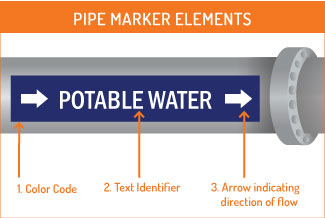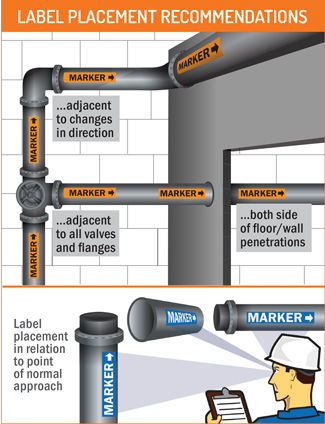Water Treatment Pipe Marking Benefits
03
February,
2023
3 MINUTE READ

Water Treatment Pipe Marking Benefits
Pipe marking is an essential part of any water treatment facility. Effective pipe marking improves safety and increases efficiency by providing essential information-where and when it's needed.
The Standards
While there is no single standard that governs all pipe marking for water treatment facilities across the U.S., there are two standards specifically developed for water treatment facilities that are in common use:
- Recommended Standards for WaterWorks (2012 edition)
- Recommended Standards for Wastewater Facilities (2014 edition)
Both of these are part of the 10 States Standards, developed by a coalition of ten U.S. states and one Canadian province-Illinois, Indiana, Iowa, Michigan, Minnesota, Missouri, New York, Ohio, Pennsylvania, Wisconsin, and Ontario.
Although these standards originally applied only to the ten states, other states have used them as a baseline for their own standards. This is because the 10 States Standards provide a wealth of reliable information that can improve safety and operations for public water works, including how to properly mark pipes.
Elements of a Pipe Marker

In general, there are five elements that make an effective pipe label. These elements are used by most pipe marking standards and include:
- Color coding provides a means for workers to quickly identify the general contents of pipes as well as potential hazards.
- Text identifies the pipe's exact contents and may also display other hazards like temperature or pressure.
- Arrows indicate the direction of flow, including when contents may flow in either direction.
- Label placement recommendations ensure people will see the label and be able to access the information they need with minimum effort.
- Size guidelines help you choose the right size label and text to ensure pipe markers can be read.
The first four elements are specifically addressed in the 10 State Standards, while guidance for the fifth can be found in another standard: ANSI/ASME A13.1. Learn more about the elements of pipe marking with our Pipe Marking Guide. The guide covers the 10 States Standards as well as ANSI/SME A13.1, detailing when and how they should be used.
Improve Safety
Water treatment facilities are complex and can contain numerous hazards. Pipe marking provides an effective means for workers to consistently identify hazards by:
- Providing information in an easy-to-read and consistent manner
- Using color-coding to support quick identification of contents
- Complimenting your chemical hazard communication program (HazCom 2012)

Supported by a comprehensive color-coding system, workers will recognize pipes, their contents, and potential hazards from a distance, enabling them to more easily prepare for work. For example, in a wastewater treatment facility, a dark green pipe lets workers know that it contains pressurized air. As a result, workers are instantly aware of the hazard and know that they need to isolate and bleed the pipes before performing work.
Another added benefit of using a standardized pipe marking scheme is that it helps you meet HazCom 2012's requirements, which requires an in-depth program for communicating chemical hazards in the workplace. By taking advantage of a relevant standard, like the 10 State Standards, you can ensure that your facility consistently communicates the hazards related to the contents of its pipes.
Increase Efficiency
Water treatment facilities can have many miles of piping, with varying contents. Workers have to perform routine maintenance to keep the facility in peak condition. Properly marked pipes aid workers in this task, ensuring that they can:
- Move from one task to the next without having to reference charts or binders
- Spend less time reviewing schematics because much of information they need is on the pipes
Located at the point of use, pipe marking helps reduce errors and mistakes caused by information gaps. Workers always know what's in the pipes. Even when workers go from one facility to the next, they can confidently and efficiently perform work.
Pipe Marking Solutions
Start marking your facility's pipes with Duralabel line of DuraLabel printers and supplies. Printers such as DuraLabel Toro enable you to print labels onsite and on the go with an optional lithium-ion battery.
Each DuraLabel printer lets you:
- Design pipe labels with just a few clicks using DuraSuite labeling software
- Add supporting graphics like hazard pictograms and arrows to meet your facility's needs
- Create labels that will last for many years
Do more than create pipe markers. With a DuraLabel printer, you can create custom safety signs and labels for your entire facility with a database of over 1,800 symbols. Improve safety throughout your facility and meet OSHA's requirements for safety signs.
If you only need a handful of pipe markers for a specific project, visit our full selection of premade pipe markers.
To help you get started, we are offering a free Pipe Marking Wall Chart to keep handy when creating pipe labels in your facility. Download below!
RELATED RESOURCES

Free OSHA GHS Training
OSHA GHS Proposal OSHA mandated changes to its hazard communication standard (HCS), and aligned itself with ...
Read
5 Solar Installation Best Practices You Need to Know
Installing solar panels can be more complex than you think. There are numerous factors to take into account ...
Read
GHS Purple Book
The GHS is described in a book, informally known as the "Purple Book." This book contains information on all ...
Read.png)


